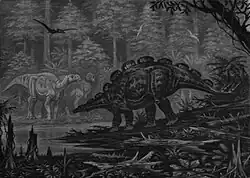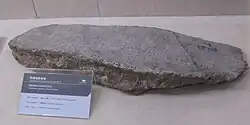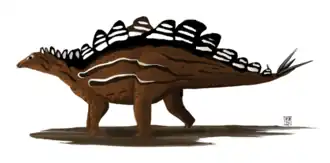Wuerhosaurus
| Wuerhosaurus Temporal range:
Early Cretaceous, | |
|---|---|

| |
| Restoration of W. homheni with low plates | |
| Scientific classification | |
| Kingdom: | Animalia |
| Phylum: | Chordata |
| Class: | Reptilia |
| Clade: | Dinosauria |
| Clade: | †Ornithischia |
| Clade: | †Thyreophora |
| Clade: | †Stegosauria |
| Family: | †Stegosauridae |
| Subfamily: | †Stegosaurinae |
| Genus: | † Dong, 1973[1] |
| Type species | |
| Wuerhosaurus homheni Dong, 1973[1]
| |
| Species | |
| Synonyms | |
| |
Wuerhosaurus is an extinct genus of stegosaurine stegosaur dinosaurs from the Early Cretaceous of China. The genus contains two species, Wuerhosaurus homheni, the type species named in 1973, and Wuerhosaurus ordosensis, named in 1993. It is one of the youngest (most recent) known stegosaurs in the fossil record, alongside Mongolostegus and Yanbeilong.[3][4]
Discovery and species

Wuerhosaurus homheni is the type species, described by Dong Zhiming in 1973 from the Tugulu Group in Xinjiang, western China. The generic name is derived from the city of Wuerho. Three separate localities in the Wuerho Valley were discovered to contain material from the new stegosaur: 64043-5, 64043 and 64045.[1] The remains consisted of the holotype, Institute of Vertebrate Paleontology and Paleoanthropology (IVPP) V.4006, a skull-less fragmentary skeleton, and the paratype IVPP V.4007.[5] Holotype material includes a mostly complete pelvis and sacrum lacking the ischium, the first caudal vertebrae, two dorsal vertebrae, a scapulocoracoid, humerus and phalanx, as well as two dermal plates. Three posterior caudal vertebrae from the tail and a partial ulna of a second individual form the paratype, and Dong referred a partial ischium from a third locality to Wuerhosaurus.[1]
A smaller stegosaur from the Ejinhoro Formation in the Ordos Basin in Inner Mongolia was found in 1988. When the specimen (IVPP V.6877) was described by Dong in 1993, it was named W. ordosensis, as it was from a similar age and had a similar anatomy. The holotype of the species includes a nearly complete torso, consisting of three cervical vertebrae, all eleven dorsal vertebrae (with attached ribs), a complete sacrum with a right ilium, and the first five caudal vertebrae, all articulated. An additional dorsal vertebra and dermal plate were referred to the taxon when it was named.[2] In 2014 Roman Ulansky named a new species of Wuerhosaurus, "W. mongoliensis" for vertebrae and pelvic material, but the name is an invalid nomen nudum.[6] It was formally described as Mongolostegus in 2018.
Description
Wuerhosaurus homheni was probably a broad-bodied animal, reaching 7 metres (23 ft) in length and 4 metric tons (4.4 short tons) in body mass.[7] Only a few scattered bones have been found, making a full restoration difficult.[8] Its dorsal plates were at first thought to have been much rounder or flatter than other stegosaurids,[9] but Maidment established this was an illusion caused by breakage: their actual form is unknown. W. homheni had a pelvis of which the front of the ilia strongly flared outwards indicating a very broad belly. The neural spines on the tail base were exceptionally tall.
In contrast, W. ordosensis was much smaller, estimated by Paul to have been 5 m (16 ft) long and weigh 1.2 metric tons (1.3 short tons). It had a relatively long neck with a broad pelvis, but the neural spines are shorter.[7]
Classification
Phylogeny
Wuerhosaurus is one of the most derived stegosaurians, being closely related to either Dacentrurus and Hesperosaurus, or Hesperosaurus and Stegosaurus, depending on phylogenetic analysis. Carpenter et al. (2001[10]) recovered Wuerhosaurus in the former relationship, close to Hesperosaurus and Dacentrurus as basal in Stegosauridae. Wuerhosaurus was recovered in a different position by Escaso et al. (2007[11]), still related to Hesperosaurus, but basal to a clade of Lexovisaurus and Stegosaurus. Maidment et al. (2008[12]) recovered a different placement with Wuerhosaurus as being in a clade of taxa in derived Stegosaurinae, most closely related to Hesperosaurus and then Stegosaurus.[12] More recently, Maidment (2017[13]) elaborated upon her earlier analyses, and instead resolved Wuerhosaurus as closest to Stegosaurus, with Hesperosaurus being more closely related to Miragaia. These results are shown below.[13]

Synonymy with Stegosaurus
Maidment and colleagues proposed in 2008 that Wuerhosaurus was a junior synonym of Stegosaurus, with W. homheni being renamed Stegosaurus homheni, and W. ordosensis being a dubious taxon. W. homheni was synonymized because the holotype that could be located was similar to Stegosaurus, and because of its phylogenetic position. Wuerhosaurus placed between Stegosaurus and Hesperosaurus, the latter being considered a species of Stegosaurus because of its age, location, and anatomy. Since Wuerhosaurus placed between two possible Stegosaurus species, Maidment et al. synonymized the taxon as well. Wuerhosaurus ordosensis was considered to be a nomen dubium because the holotype could not be found in the IVPP collections. The original description did not mention any valid diagnostic traits, and no other description provided features either, so Maidment et al. considered the taxon undiagnostic.[12] This opinion has been contested, however, by Carpenter (2010[14]). He discussed how the diagnoses and features used by Maidment et al. were inconsistent and generalized, with Wuerhosaurus homheni bearing numerous differences. As such, Carpenter advocated for the separation of both Hesperosaurus and Wuerhosaurus from Stegosaurus.[14] In 2017, Hou and Ji described and isolated stegosaur sacrum with paired ilia that they referred to W. ordosensis based on similarities to the holotype. The researchers concluded that several anatomical features separated this species from W. homheni.[15]
Paleoecology
The type species, W. homheni, is known from the Tugulu Group, while W. ordosensis is known from the Ejinhoro and Luohandong Formations.[15] The approximate age of Wuerhosaurus is 130 mya, based on the approximate dating of the Tsaganstabian fauna, and thus the stegosaur would have lived in the Hauterivian era, which is roughly coeval with the Wealden group, from which other stegosaur material has been found.[16] Uranium-lead dating has shown that the age of Wuerhosaurus in the Lianmuqin Formation of the Tugulu Group is slightly younger than 135.2 million years old, while Wuerhosaurus in the Ejinhoro Formation is from the Barremian.[17] Stegosaur footprints from the Tugulu Group in Xinjiang Province, China, have been attributed as registered by W. homheni individuals.[18] These tracks include the world's smallest stegosaur tracks, measuring 5.7 cm in length, indicative of a dinosaur that was approximately cat-sized.[19]
See also
References
- ^ a b c d e Dong, Z. (1973). "Dinosaurs from Wuerho". Reports of Paleontological Expedition to Sinkiang (II): Pterosaurian Fauna from Wuerho, Sinkiang (in Chinese). Vol. 11. Memoirs of the Institute of Vertebrate Paleontology and Paleoanthropology, Academia Sinica. pp. 45–52.
- ^ a b Dong, Z. (1993). "A new species of stegosaur (Dinosauria) from the Ordos Basin, Inner Mongolia, People's Republic of China". Canadian Journal of Earth Sciences. 30 (10): 2174–2176. Bibcode:1993CaJES..30.2174D. doi:10.1139/e93-188.
- ^ Tumanova, T. A.; Alifanov, V. R. (2018-12-01). "First Record of Stegosaur (Ornithischia, Dinosauria) from the Aptian–Albian of Mongolia". Paleontological Journal. 52 (14): 1771–1779. Bibcode:2018PalJ...52.1771T. doi:10.1134/S0031030118140186. ISSN 1555-6174. S2CID 91559457.
- ^ Jia, Lei; Li, Ning; Dong, Liyang; Shi, Jianru; Kang, Zhishuai; Wang, Suozhu; Xu, Shichao; You, Hailu (2024-01-31). "A new stegosaur from the late Early Cretaceous of Zuoyun, Shanxi Province, China". Historical Biology. 37 (2): 420–429. doi:10.1080/08912963.2024.2308214. ISSN 0891-2963.
- ^ Dong, Z. (1990). "Stegosaurs of Asia". In Carpenter, Kenneth; Currie, Philip J. (eds.). Dinosaur Systematics: Approaches and Perspectives. Cambridge University Press. pp. 255–268. ISBN 978-0-521-43810-0.
- ^ Galton, P.M.; Carpenter, K. (2016). "The plated dinosaur Stegosaurus longispinus Gilmore, 1914 (Dinosauria: Ornithischia; Upper Jurassic, western USA), type species of Alcovasaurus n. gen."". Neues Jahrbuch für Geologie und Paläontologie - Abhandlungen. 279 (2): 185–208. Bibcode:2016NJGPA.279..185G. doi:10.1127/njgpa/2016/0551.
- ^ a b Paul, G.S. (2016). The Princeton Field Guide to Dinosaurs (2 ed.). Princeton University Press. p. 248. ISBN 978-0-691-16766-4.
- ^ Palmer, D., ed. (1999). The Marshall Illustrated Encyclopedia of Dinosaurs and Prehistoric Animals. London: Marshall Editions. p. 156. ISBN 1-84028-152-9.
- ^ Dodson, P., ed. (1993). "Wuerhosaurus". The Age of Dinosaurs. Publications International, LTD. p. 102. ISBN 0-7853-0443-6.
- ^ Carpenter, K.; Miles, C.A.; Cloward, K. (2001). "New primitive stegosaur from the Morrison Formation, Wyoming". In Carpenter, K. (ed.). The Armored Dinosaurs. Indiana University Press. pp. 55–75. ISBN 978-0-253-33964-5.
- ^ Escaso, F.; Ortega, F.; Dantas, P.; Malafaia, E.; Pimentel, N.L.; Pereda Suberbiola, X.; Sanz, J.L.; Kullburg, J.C.; Kullburg, M.C.; Barriga, F. (2007). "New evidence of shared dinosaur across Upper Jurassic Proto-North Atlantic: Stegosaurus from Portugal" (PDF). Naturwissenschaften. 94 (5): 367–374. Bibcode:2007NW.....94..367E. doi:10.1007/s00114-006-0209-8. PMID 17187254. S2CID 10930309.
- ^ a b c Maidment, Susannah C.R.; Norman, David B.; Barrett, Paul M.; Upchurch, Paul (2008). "Systematics and phylogeny of Stegosauria (Dinosauria: Ornithischia)". Journal of Systematic Palaeontology. 6 (4): 367–407. Bibcode:2008JSPal...6..367M. doi:10.1017/S1477201908002459. S2CID 85673680.
- ^ a b Raven, T.j.; Maidment, S.C.R. (2017). "A new phylogeny of Stegosauria (Dinosauria, Ornithischia)" (PDF). Palaeontology. 2017 (3): 1–8. Bibcode:2017Palgy..60..401R. doi:10.1111/pala.12291. hdl:10044/1/45349. S2CID 55613546.
- ^ a b Carpenter, K. (2010). "Species concept in North American stegosaurs". Swiss Journal of Geosciences. 103 (2): 155–162. Bibcode:2010SwJG..103..155C. doi:10.1007/s00015-010-0020-6. S2CID 85068121.
- ^ a b Hou, Yandong; Ji, Shu'an (July 2017). "内蒙古鄂尔多斯盆地下白垩统罗汉洞组剑龙类化石新材料" [New findings of stegosaurs from the Lower Cretaceous Luohandong Formation in the Ordos Basin, Inner Mongolia.]. Geological Bulletin of China. 36 (7): 1097–1103.
- ^ Donovan, T. (2002). "RE: Tsagantsabian age". Dinosaur Mailing List. Cleveland Museum of Natural History. Retrieved 2018-01-08.
- ^ Zheng, D.; Chang, S.-C.; Ramezani, J.; Xu, X.; Xu, H.; Wang, H.; Pei, R.; Fang, Y.; Wang, J.; Wang, B.; Zhang, H. (2021). "Calibrating the Early Cretaceous Urho Pterosaur Fauna in Junggar Basin and implications for the evolution of the Jehol Biota". GSA Bulletin. 136 (1–2): 765–773. doi:10.1130/B36795.1.
- ^ Xing, Lida; Lockley, Martin G.; Persons, W. Scott; Klein, Hendrik; Romilio, Anthony; Wang, Donghao; Wang, Miaoyan (2021-02-28). "Stegosaur Track Assemblage from Xinjiang, China, Featuring the Smallest Known Stegosaur Record". PALAIOS. 36 (2): 68–76. Bibcode:2021Palai..36...68X. doi:10.2110/palo.2020.036. ISSN 0883-1351. S2CID 233129489.
- ^ Queensl, The University of; Lucia, Australia Brisbane St; Gatton, QLD 4072 +61 7 3365 1111 Other Campuses: UQ; Maps, UQ Herston; Queensl, Directions © 2021 The University of. "Tiny cat-sized stegosaur leaves its mark". UQ News. Retrieved 2021-04-19.
{{cite web}}: CS1 maint: numeric names: authors list (link)
- Dong Zhiming (1992). Dinosaurian Faunas of China. China Ocean Press, Beijing. ISBN 3-540-52084-8.
